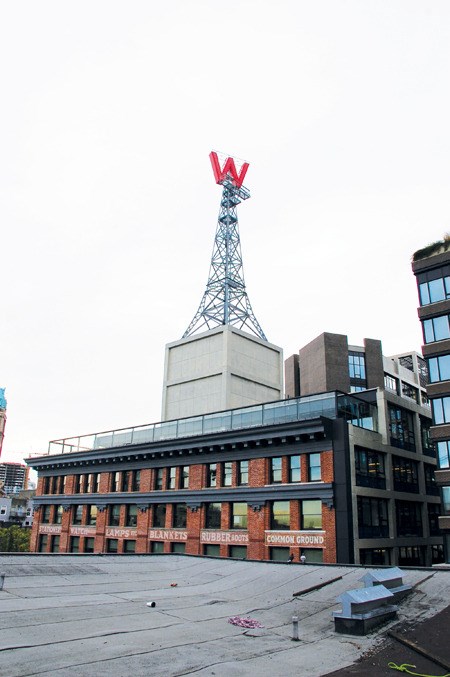The hallway inside the Metropole is hot, humid and smells of industrial cleaner and cigarette smoke. The long strips of coloured linoleum fleshy peach flanked by avocado look institutional, like something out of an abandoned public school.
On the one side of the divide lives the man who calls himself Esra. On the other, the young woman who calls herself Jenny. Neither wants their real name associated with this, a Single Room Occupancy (SRO) residence above a newly revamped pub of the same name.
Neither calls this place their home, though they both live here.
A bespectacled 34-year-old with ice blue eyes, a detectable Dutch accent and brown hair laced with grey, Esra contends hes not a typical resident of this area of town; one thats become increasingly hard to define.
I say I live in the nexus between Chinatown, Downtown, Gastown and Cracktown.
Educated, entrepreneurial and an abstainer from drugs and alcohol, Esra insists he stands apart from the fold. But he does battle mental illness, its his reason for landing on this part of Abbott Street and something he shares with many living further east along Hastings.
The anxiety is better than the depression, he says. The former is an inspiration to take action, but in the throes of the latter you can just hibernate, hide away in your one-room unit for days.
You learn that you can only have real friendships with people who know what its like, at least somewhat, he says.
If youre lucky, you learn how to manage the mental illness. You find a place you can afford $500 for 200 square feet on your disability payment. You take your medication every day, keeping careful track of the pills in a plastic briefcase full of tiny compartments.
You keep yourself busy. Crafting, sewing, getting out in the neighbourhood and watching it change.
Theres a lot of action on that front.
When I first moved here it was Third World, now its Second World, says Esra, pleased with the addition of the Woodwards development that went up across the street.
When he arrived down here in 2005, the derelict department store was still a squatters free-for-all, ground zero for bitter clashes between anti-poverty activists and city brass.
Now that its built, things have calmed down. The public atrium is teeming with activity, but many still see Woodwards as nothing more than a $400-million monument to gentrification.
Esra agrees thats probably true, though in his view its not a bad thing. Its like an upside-down parasite, he says. Its injecting positive things in a bad space.
The experimental complex the only place in town where youll find social housing and upscale condos, nightclubs and social services agencies on the same block has undeniably changed the demographics in the area, pushing the poverty line east. My neighbours used to be drug users, now theyre drug dealers because the rent has gone up, Esra reports.
 The 60 W. Cordova development (right) next door to The Met. Jessica Barrett photo
The 60 W. Cordova development (right) next door to The Met. Jessica Barrett photo
And theres another kind of neighbour moving in.
Jenny is soft-spoken and shy. She wraps her arms protectively around her torso as she leans against the door of her suite at The Met. She moved in about two months ago and hardly seems a threat to the social fabric of the neighbourhood, though anti-poverty activists have been warning against the likes of her for years.
With Woodwards completed and rents on the rise in the neighbouring SROs, middle-class students like Jenny are being drawn to the area for its newfound status as a hip and edgy hood. These new arrivals are, poverty advocates warn, displacing the areas poor.
From where Jennys standing, its not quite that simple.
The 26-year-old psychology student admits shes likely the harbinger of the next wave of change to hit the area. Perhaps eight or 10 other university-educated, middle-class kids have recently moved nearby, she reports. But the newcomers werent beckoned by the neighbourhoods emerging trendiness, she says. They arrived out of necessity.
I cant believe Im paying this much to live in the Downtown Eastside, she says. Growing up in Kitsilano and Shaughnessy people would tell hwer shed never have to live in this part of town, that it was the last resort for affordable housing. But a university student out of work in a crummy economy, her room is the only place she can afford thats near transit. And as it stands, its nearly out of her reach.
Jennys 200-square-feet is a mirror image of Esras across the hall, but thanks to the renovations and adjustments for property tax and inflation, shes paying $700 a month compared to the $500 he enjoys as a long-term tenant. Despite the premium, her suite is still not immune to the bedbugs and the cockroaches that plague The Met.
With rents upwards of $2,000 in Woodwards, and condos under construction next door in 60 West Cordova starting at $219,000, the attempts to create affordable housing on the open market seem like a pipe dream for Jenny. She says all they do is raise the cachet of the area, justifying the rising rents in the SROs.
This place is supposed to be the lower end of the scale. Where are these people going to live? she asks, stepping out of the way and allowing foot traffic to pass down The Mets well-travelled hall.
In the Downtown Eastside, or whatever you want to call this community on the cusp, thats certainly the $400 million question.



